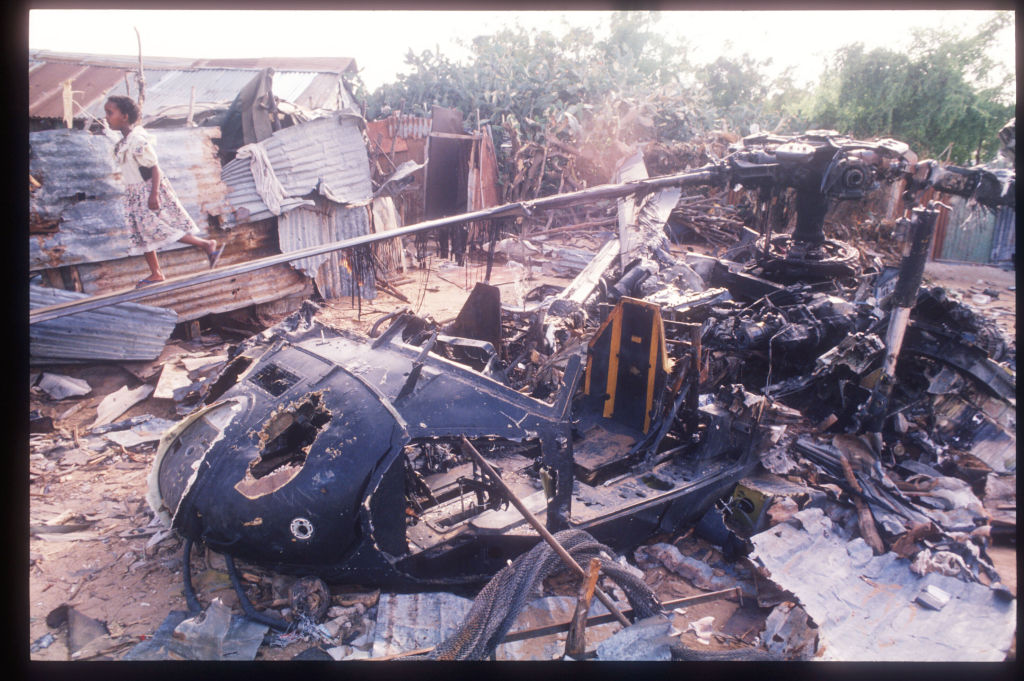Table of Contents

Ridley Scott’s Oscar-winning 2002 movie Black Hawk Down famously portrayed the story of the Battle of Mogadishu, when Black Hawk helicopters were shot down by Somali forces in 1993.
But the film was fictional, largely focusing on the perspective of U.S. soldiers. Now a new Ridley Scott Associates’ docu-series Surviving Black Hawk Down, out on Netflix Feb. 10, aims to tell an unfiltered story of that battle through the perspectives of not only the American military personnel who were there, but also the Somalis.
[time-brightcove not-tgx=”true”]
Here’s what to know about the Battle of Mogadishu, the most devastating moments in the docu-series, and how U.S. veterans interviewed are grappling with the battle today.
How the Battle of Mogadishu started
The goal of the U.S. intervention in Mogadishu in 1992 was supposed to be straightforward: feed people starving from a famine. Americans hoped to prevent attacks on UN Relief operations by followers of Somali warlord Mohamed Farrah Aidid.
But U.S. troops encountered a great amount of resistance. As TIME reported in its Oct. 18, 1993, issue, at 3:30pm on Oct. 3, 100 U.S. Rangers and 12 Blackhawk helicopters raided a site where followers of Aidid were meeting. Forty-five minutes later, the Americans captured 19 prisoners and were ambushed by Somali militia members. Black Hawk helicopters came crashing down. Over four days, at least 18 Americans died.
An estimated 200 Somalis died, but the death count has never been finalized. “Americans did not see pictures of the Somali casualties, though,” according to the magazine. “What they did see were ghastly photos of a white body, naked except for green underwear—apparently the corpse of a downed helicopter crewman—being dragged through the street while Somalis kicked and stamped at him, plus TV footage of a terrified helicopter pilot, Michael Durant being questioned by Somali captors.”
Durant was released after 11 days. He told a Red Cross worker and two journalists who visited him in captivity that Somalis “beat me violently with their fists and with sticks” and then ripped off his clothes so they could hoist him naked, blind-folded, hands bound, over the heads of raging crowds.

On Oct. 7, President Bill Clinton announced that all U.S. troops would be pulled out of combat by March 1994. According to the U.S. State Department’s website, “The United States has long had to face the challenge of determining to what degree it wants to participate in global peacekeeping efforts and whether or not U.S. lives should be put at risk for peacekeeping. Events in Somalia between 1992 and 1994 threw that debate into sharp relief.”
TIME reported that it was initially unclear exactly why President George H.W. Bush launched the Somali intervention in December of 1992, a month after Bill Clinton defeated him in the presidential election. As TIME recounted the leading theories back then:
The immediate causes were, of course, ghastly TV pictures of famine in that country and U.N. Secretary-General Boutros Boutros-Ghali‘s pleas for help to get food past the guns of armed gangs into the hands of the starving in a country that had no real government and practically no order of any sort. In addition, Bush no doubt wanted to go out in a blaze of glory as a world statesman, and subordinates were glad that the move served as a sort of therapy for the funk he was in after his election defeat.
What it was like on the ground during the Battle of Mogadishu
For U.S. military personnel in Somalia, October 3, 1993, was supposed to be a day off. They started the day relaxing on the beach and playing the board game RISK before they were urgently called to work.
“There were four of us at the beach this morning, and two of us aren’t here anymore,” says Brad Thomas of the U.S. Army Rangers, describing losing two of his best friends in the Battle of Mogadishu. Thomas, who was part of the convoy evacuating casualties, recalls “driving around in circles being shot at.”
Durant, who was taken hostage, appears in the docu-series and describes being hit with something soft and realizing it was the arm of a crew member. “I thought, there’s no way out of here,” he says.
Some of the U.S. military personnel did not agree with President Clinton’s decision to pull American troops out of Somalia. “My friends died,” Tom Slattery of Delta Force says in the doc, “and now you want to pull out? That’s a waste of lives. We’ve wasted our time. We’ve wasted these lives, and I was enraged. Pissed. Pissed, pissed, pissed.”
Americans watching TV news on the homefront in 1993 saw mostly footage of Somalis doing the attacking. But Surviving Black Hawk Down sheds light on the immense suffering that Somali civilians faced during the battle. The series includes footage taken by a man known as Ahmed “Five,” who shifted from filming parties and events to trying to document as much of the turmoil as possible. “The situation needed to be recorded,” he says. Some of the most harrowing frames of the footage showed victims—mostly elders—taking their last breaths, as well as a boy with blood all over his clothes.

When the raid was going on, a Somali woman named Halima recalls being at a nearby school with 20 children huddled on top of her, vomiting and passing out. When the school was evacuated, she says she ran barefoot as helicopters soared overhead. “I lost hope in life,” she says
A Somali woman named Binti Adan appears in the doc with her daughter Ifrah, who lost her eyesight from injuries sustained during the siege. “There’s nothing worse than losing the eyes,” she says, tearfully. “She was just a child.”
U.S. veterans open up
The Battle of Mogadishu may technically be over, but the U.S. military personnel who were there are very much still affected by it.
Thomas, now a musician who contributes his royalties to charitable organizations that help first responders in need, tells TIME he’s glad that the new series includes more voices of survivors. “The movie Black Hawk Down has kind of become the official narrative, and anyone that knows me will ask me, how real was the movie?” he says. “I didn’t have a voice in that story, and now I’ve been able to share my part of the battle and the things that I saw.”

When Slattery came back from the Battle of Mogadishu, he remembers not saying anything on the drive home. Then, when he got to his kitchen, and his wife asked how his deployment was, he broke down. “I just started bawling,” he tells TIME. “It was very devastating to come home and have to try to explain to people what you went through. It’s just impossible.”
He’s reminded of the battle whenever he goes to the beach because his base in Somalia was by the sea. The smell of bleach triggers memories of cleaning up the blood that was all over the tarmac of the base.
Nowadays, Slattery is the CEO and co-founder of the All Secure Foundation, which helps Special Operations families recover from post-traumatic stress and reintegrate into American society.
He hopes that Surviving Black Hawk Down will give people a better appreciation for what U.S. military personnel go through. “They’re not Team America. They’re humans. They’re highly trained to do the best they can,” he says. “And when they come home, they’re hit with post traumatic stress that they continue to have to deal with for the rest of their lives. I want people to get the real story of what war does to humans.”



